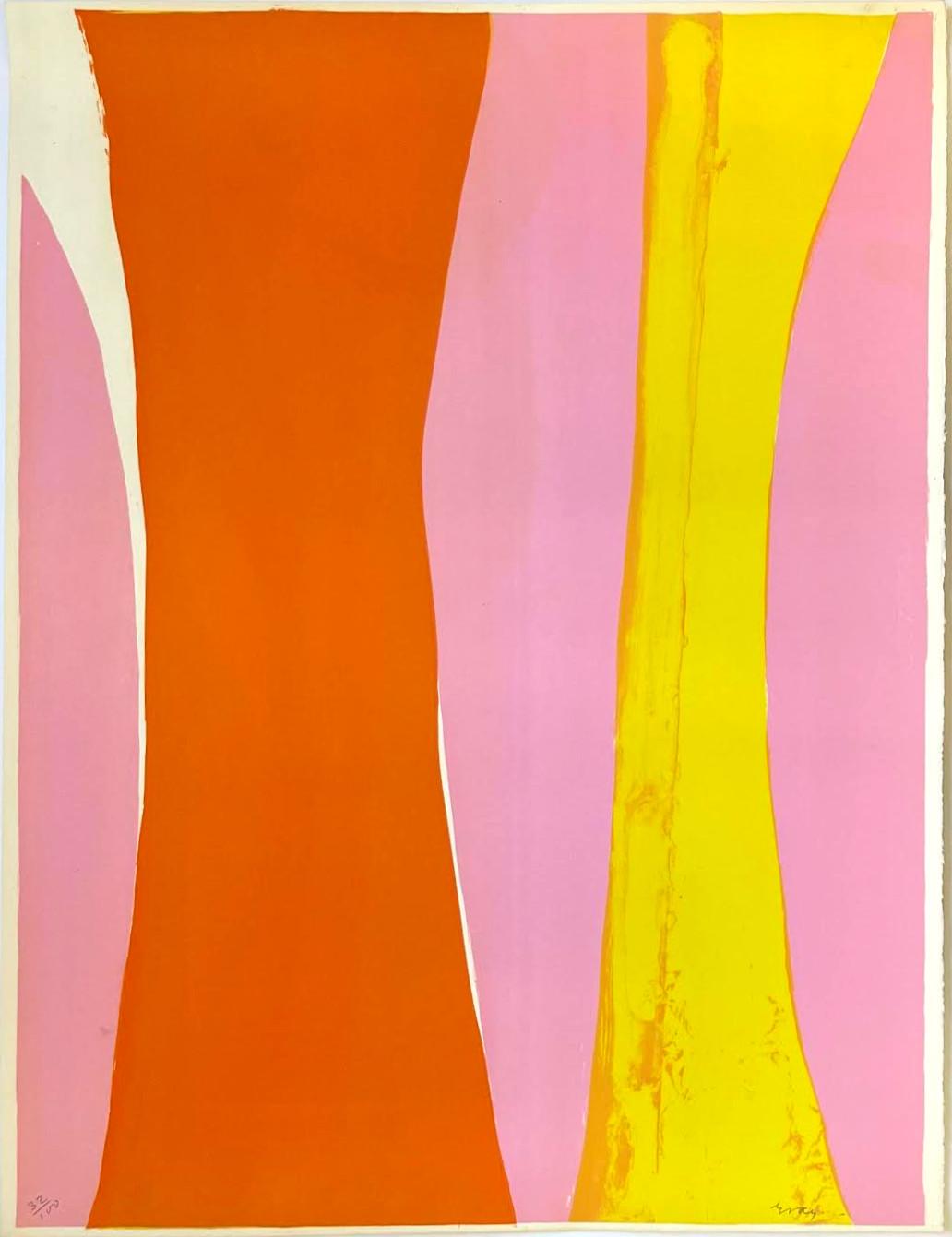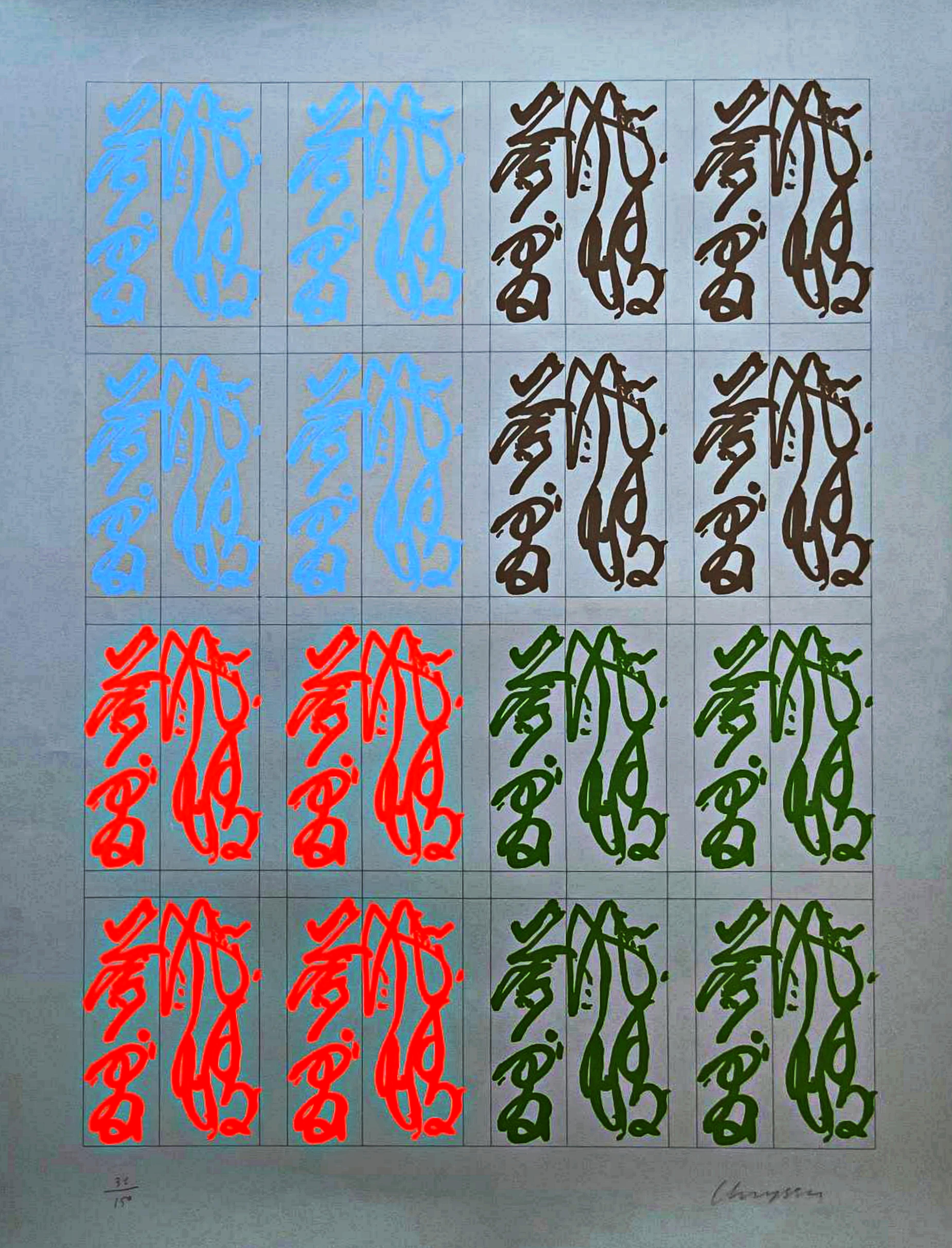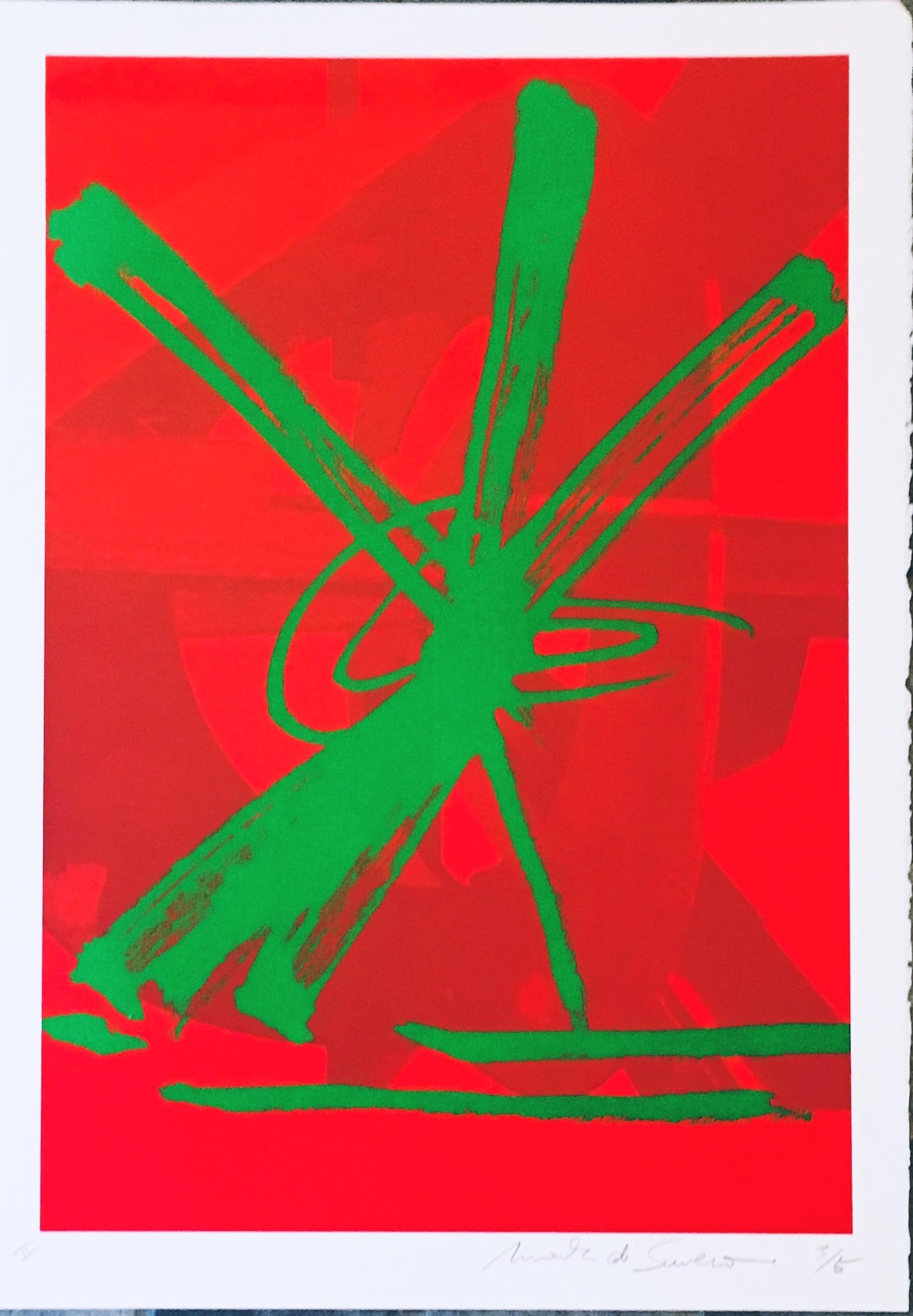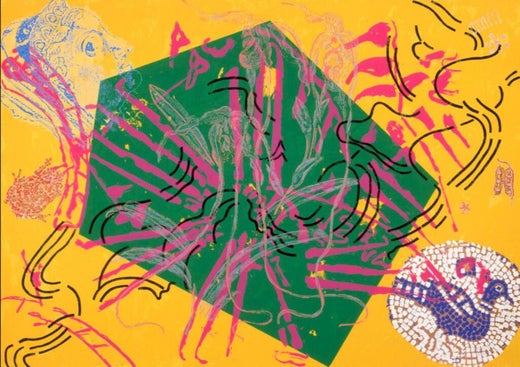Items Similar to 5745, for the Jewish Museum original signed/n abstract expressionist screenprint
Want more images or videos?
Request additional images or videos from the seller
1 of 6
Nancy Graves5745, for the Jewish Museum original signed/n abstract expressionist screenprint1984
1984
About the Item
Nancy Graves
5745, for the Jewish Museum, 1984
Silkscreen on paper
Signed, numbered 5/90 and dated in graphite pencil on the front; bears publishers' blind stamp front left corner
30 1/4 × 40 1/2 inches
Unframed
Commissioned by the Mr. and Mrs. Albert A. List Graphic Fund for The Jewish Museum, New York
Signed, numbered and dated in graphite pencil on the front; bears publishers' blind stamp front left corner. Commissioned by the Mr. and Mrs. Albert A. List New Year's Graphic Fund for The Jewish Museum, New York. During the 1980s, various artists were commissioned to create a print celebrating the Jewish New Year. This is the silkscreen renowned sculptor Nancy Graves created to celebrate the year 5745 of the Jewish Calendar, beginning in September 1984 (Rosh Hashanah). This work was published in a limited edition of 90. The number 90 has special significance in Jewish gamatria (numerology) for several reasons, including the fact that it equals five times life - or Chai. The number for Chai, meaning "Life " s 18, and 18 x 5 = 90. This is a magical number in Judaism. All of the works were published in editions that were multiples of 18, or the Life. In her lifetime, Nancy Graves did not receive the renown or acknowledgement that her ex-husband and former Yale School of Art classmate Richard Serra did, but she is finally getting the recognition she richly deserves.
Biography: Nancy Graves (1939 – 1995) is an American artist of international renown. A prolific cross-disciplinary artist, Graves developed a sustained body of sculptures, paintings, drawings, watercolors, and prints. She also produced five avant-garde films and created innovative set designs.
Born in Pittsfield Massachusetts, Graves graduated from Vassar College in 1961. She then earned an MFA in painting at Yale University in 1964, where her classmates included Robert Mangold, Rackstraw Downes, Brice Marden, Chuck Close, as well as Richard Serra with whom she was married from 1964 to 1970. Five years after graduating, her career was launched in 1969 when she was the youngest artist — and only the fifth woman — to be selected for a solo presentation at the Whitney Museum of Art. Graves’ work was subsequently featured in hundreds of museum and gallery exhibitions worldwide, including several solo museum exhibitions. She was awarded commissions for large-scale site-specific sculptures and her work is in the permanent collections of major art museums. A frequent lecturer and guest artist, her work was widely documented during her lifetime. In 1991 she married veterinarian Dr. Avery Smith. Graves travelled extensively and was fully engaged with the cultural and intellectual issues of her times. Her brilliant career and life were cut short by her untimely death from cancer at age 54.
From a point of view that she described as “objective,” Graves transformed scientific sources, such as maps and diagrams, into artworks by re-producing their complex visual information in detailed paintings and drawings. Investigating the intersections between art and scientific disciplines, Graves created compelling, formally rigorous, yet ultimately expressive works of art that examine concepts of repetition, variation, verisimilitude, and the presentation and perception of visual information.
Based in SoHo, New York, Graves gained prominence in the late 1960s as a post-Minimalist artist for innovative camel, fossil, totem, and bone sculptures that were hand formed and assembled from unusual materials such as fur, burlap, canvas, plaster, latex, wax, steel, fiberglass and wood. Made in reaction to Pop and Minimalism, these works reference archaeological sites, anthropology, and natural science displays. Suspended from the ceiling or clustered directly on the floor, these early sculptures also engage with Conceptualist ideas of display. For her Whitney Museum presentation Graves exhibited three seemingly realistic sculptures of camels in an installation that evoked taxidermy specimens and questioned issues of verisimilitude in art and science, particularly in light of their hand patched and painted fur surfaces. The exhibition elicited wide spread critical responses and established her artistic significance.
After intensely engaging with sculpture in the early 1970s, Graves returned to painting. Her detailed pointillist canvasses re-produced — in paint — images culled from documentary nature photographs, NASA satellite recordings, and Lunar maps, commingling scientific exactitude with abstraction. Resuming sculpture in the late 1970s, Graves was among the first contemporary artists to experiment with bronze casting. She re-invigorated the traditional lost wax technique by assembling cast found objects into unique improbably balanced sculptures, with bright polychrome surfaces and distinctive patinas.
Throughout the 1980s Graves became widely recognized for her increasingly large and graceful open-form sculpture commissions. At the same time, she also expanded her drawing, painting, and printmaking practice and made large gestural watercolors. Then, in the late 1980s she created wall-mounted works that combined her explorations of sculpture, painting, form and color. In these large-scale pieces, she mounted high relief polychrome sculptural elements to the surfaces and edges of painted shaped canvases so that patterned shadows were cast onto the paintings and surrounding wall.
By the 1990s Graves was casting in glass, resin, paper, aluminum, and bronze, combining these varied materials and colors into daring sculptures with moving parts. As she proceeded in all the media she mastered, Graves increasingly re interpreted and transmuted forms sourced from her own earlier artwork — rather than from outside research — creating elaborate compositions that form a layered a-temporal archaeology of her own visual production.
Nancy Graves’ pioneering art anticipated ideas being explored by artists today such as data mining, multi disciplinarity, technology, and research-based art. Her work addresses philosophical, perceptual, aesthetic and technological issues that are especially relevant to making art in the digital age. - Courtesy Nancy Graves Foundation
- Creator:Nancy Graves (1940-1995, American)
- Creation Year:1984
- Dimensions:Height: 30.25 in (76.84 cm)Width: 40.5 in (102.87 cm)
- Medium:
- Movement & Style:
- Period:
- Condition:Very good condition with no apparent issues; a bright impression.
- Gallery Location:New York, NY
- Reference Number:1stDibs: LU1745214368302
Nancy Graves
A sculptor of animals and American Indian shamanistic objects, filmmaker, and painter, Nancy Graves had a highly successful and varied career, primarily in New York City. In her abstract work, she united her interest in anthropology, totemic objects, cartography, and biomorphic shapes. She was born in Pittsfield, Massachusetts, and became a graduate of Vassar College in 1961 and then Yale University's School of Art and Architecture. Graves won a Fulbright-Hayes Fellowship for painting, allowing her to spend a year in Paris in 1964-65. In the next few years, she traveled in North Africa and the Near East and lived and worked in Florence, Italy where she did her first signature work, which was sculptures of life-size Bactrian camels.
In 1966, she moved to New York City and further experimented with ways to produced these sculptures by building wood and steel armatures, covering them with skins of animal embryos, stuffing the skins with polyurethane to form humps, and tinting the skins with oil paints.
In 1968, she had her first New York one-woman show at the Graham Gallery followed by her second one-woman show at the Whitney Museum in 1969. Both exhibitions featured her camels.
In 1972 at the Philadelphia Institute of Contemporary Art, she made sculpture suggestive of Indian objects such as bones, skins, and feathers and added also steel rods to this motif for other exhibitions.
As a filmmaker, she has had showings in film festivals in London, New York, and Boston. Source: Charlotte Rubinstein, "American Women Artists"
About the Seller
5.0
Platinum Seller
These expertly vetted sellers are 1stDibs' most experienced sellers and are rated highest by our customers.
Established in 2007
1stDibs seller since 2022
304 sales on 1stDibs
Typical response time: 1 hour
- ShippingRetrieving quote...Ships From: New York, NY
- Return PolicyA return for this item may be initiated within 1 day of delivery.
More From This SellerView All
- Untitled Abstract Expressionist color band - rare silkscreen signed & numberedBy Cleve GrayLocated in New York, NYCleve Gray Untitled, 1970 Silkscreen Boldly signed and numbered 32/100 in graphite pencil by Cleve Gray on the front 30 × 22 1/2 inches Signed and numbered 32/100 by artist on the fr...Category
1970s Abstract Expressionist Abstract Prints
MaterialsScreen, Pencil, Graphite
- Sicilian Magician - lt ed silkscreen by renowned abstract expressionist painterBy Walter Darby BannardLocated in New York, NYWalter Darby Bannard Siciliian Magician, 1980 Silkscreen on wove paper Pencil signed, titled and dated by the artist on the front Unframed Provenance: Bart Gallery, Providence, RI Th...Category
1980s Abstract Expressionist Abstract Prints
MaterialsScreen, Pencil, Graphite
- Chinatown Portfolio II Plate Three Signed Silkscreen Large 40 x 38" Greek artistBy Chryssa Vardea-MavromichaliLocated in New York, NYChryssa Chinatown Portfolio II, Plate Three, ca. 1978 Silkscreen on thick wove paper 40 × 30 1/2 inches (Ships rolled in a tube measuring 35 x 5 x 5) Pencil signed and numbered 36/150 on the front; bears printers stamp on the back Unframed from the Chinatown Portfolio Printed by Atelier Arco in Paris (with stamp on the back of the print) from the Chinatown Portfolio Renowned Greek-American artist Chryssa was preoccupied with the concept of Chinese letters as art forms, which she explores in her Chinatown silkscreen series. Her deliberate experimentations yield an elegant and compelling result. Chryssa Biography Chryssa Vardea...Category
1970s Abstract Abstract Prints
MaterialsScreen, Pencil, Graphite
- Future Shadow II Abstract Expressionist lithograph pencil signed numbered 3/5By Mark di SuveroLocated in New York, NYMark di Suvero Future Shadow II, ca. 2001 Lithograph on Arches 88 Paper with Deckled Edges Signed and numbered from an edition of 5 by the artist on the front 32 × 23 inches Unframed The work was gifted directly by the artist to the present owner. This is a variation of a print the artist created as a donation to the Venice California...Category
Early 2000s Abstract Expressionist Abstract Prints
MaterialsLithograph, Pencil
- Deluxe Hand Signed & Numbered 25/30 Cat: Lembark 155 Carnegie Museum lithographBy Sam FrancisLocated in New York, NYSam Francis Untitled Abstract Expressionist lithograph (Hand Signed from the Carnegie Museum Deluxe Edition), 1972 Catalogue Raisonné: 155, Lembark 15 × 22 inches Hand signed and nu...Category
1970s Abstract Expressionist Abstract Prints
MaterialsPencil, Lithograph
- Lt Ed. Lithograph from the Deluxe (Hand Signed) 1984 Olympic Committee portfolioBy Sam FrancisLocated in New York, NYSam Francis Untitled Abstract Expressionist print for the 1984 Olympics, 1982 Offset Lithograph on Parsons Diploma Parchment paper, hand signed with COA from publisher for Olympic Co...Category
1980s Abstract Expressionist Abstract Prints
MaterialsLithograph, Offset, Pencil
You May Also Like
- The Basque Suite #10By Robert MotherwellLocated in New York, NYA very good impression of this color screenprint on J. B. Green paper. Initialed and numbered 115/150 in pencil. Printed by Kelpra Studio, London, with the ink stamp verso. Published...Category
1970s Abstract Expressionist Abstract Prints
MaterialsColor, Screen
- SignsBy Adolph GottliebLocated in New York, NYA very good impression of this scarce color screenprint on white wove paper. Signed, dated and numbered 44/75 in pencil. Published by Marlborough Graphics, Inc., New York.Category
1960s Abstract Expressionist Abstract Prints
MaterialsColor, Screen
- ConcordBy James BrooksLocated in New York, NYA very good impression of this color screenprint on white wove paper. Signed, dated and numbered 83/200 in pencil. Printed by Styria Studio, Inc., New York, with the blind stamp lowe...Category
1970s Abstract Expressionist Abstract Prints
MaterialsColor, Screen
- Night St. MaximeBy Cleve GrayLocated in New York, NYA very good impression of this color screenprint on Rives BFK. Signed and numbered 68/100 in pencil by Gray. Dimensions with the frame are 31 x 23 inches.Category
1980s Abstract Expressionist Abstract Prints
MaterialsColor, Screen
- SonataBy Mark TobeyLocated in New York, NYA very good, richly-inked impression of this color screenprint on Japon nacré. The deluxe, Roman numeral edition of 60 on Japon nacré, aside from the regular edition of 100. Signed a...Category
1970s Abstract Expressionist Abstract Prints
MaterialsScreen, Color
- Flashback IIIBy John ChamberlainLocated in New York, NYA very good impression of this color screenprint on Rives BFK. Signed and numbered 40/175 in pencil by Chamberlain. Published by London Arts, Inc., Detroit, with the blind stamp lowe...Category
1980s Abstract Expressionist Abstract Prints
MaterialsColor, Screen






